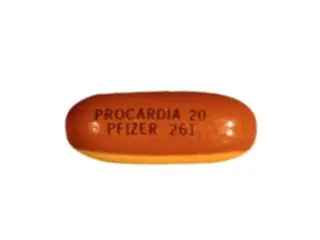| Package | Dosage | Price | Price per Dose | |
|---|---|---|---|---|
| Dosage: 10mg | ||||
| 360 pill | 10mg | CAD388.21 | CAD1.08 | |
| 180 pill | 10mg | CAD211.39 | CAD1.17 | |
| 120 pill | 10mg | CAD153.73 | CAD1.29 | |
| 90 pill | 10mg | CAD128.75 | CAD1.42 | |
| 60 pill | 10mg | CAD98.00 | CAD1.63 | |
| 30 pill | 10mg | CAD57.64 | CAD1.92 | |
| Dosage: 20mg | ||||
| 360 pill | 20mg | CAD463.16 | CAD1.29 | |
| 180 pill | 20mg | CAD255.60 | CAD1.42 | |
| 120 pill | 20mg | CAD192.17 | CAD1.60 | |
| 90 pill | 20mg | CAD165.27 | CAD1.83 | |
| 60 pill | 20mg | CAD124.91 | CAD2.09 | |
| 30 pill | 20mg | CAD78.78 | CAD2.65 | |
| Dosage: 30mg | ||||
| 180 pill | 30mg | CAD497.76 | CAD2.77 | |
| 120 pill | 30mg | CAD359.38 | CAD3.00 | |
| 90 pill | 30mg | CAD294.03 | CAD3.27 | |
| 60 pill | 30mg | CAD222.92 | CAD3.71 | |
| 30 pill | 30mg | CAD130.67 | CAD4.38 | |
| 10 pill | 30mg | CAD49.95 | CAD5.07 | |

Nifedipine Description
Understanding Nifedipine
Nifedipine is a medication primarily used to manage high blood pressure and certain types of chest pain, such as angina. It belongs to a class of drugs known as calcium channel blockers, which work by relaxing the blood vessels. This relaxation allows blood to flow more easily, helping to lower blood pressure and reduce the workload on the heart. Nifedipine is available in various forms, including immediate-release tablets and extended-release formulations, offering flexible options for different treatment needs.
How Nifedipine Works
Nifedipine specifically targets the calcium channels in the smooth muscles of blood vessels. By blocking these channels, it prevents calcium from entering the cells. Calcium is essential for muscle contraction, so inhibiting its entry causes the muscles to relax. The result is vasodilation, or widened blood vessels, which leads to decreased vascular resistance and lower blood pressure. This mechanism also helps improve oxygen supply to the heart in cases of angina, alleviating chest pain caused by insufficient blood flow.
Effectiveness and Benefits
Many users find Nifedipine effective in controlling hypertension. It is often prescribed as part of comprehensive cardiovascular management. Patients notice improvements in symptoms such as reduced chest pain and better blood pressure readings. The extended-release formulations offer the convenience of once-daily dosing and provide more stable blood levels, which helps prevent sudden spikes in blood pressure. Overall, Nifedipine contributes significantly to reducing the risk of heart attacks, strokes, and other cardiovascular complications.
Possible Side Effects
Like all medications, Nifedipine can cause side effects. Commonly reported issues include headaches, flushing, dizziness, and swelling of the ankles or feet. These effects are usually mild and tend to decrease over time. Some users may experience a rapid heartbeat or feelings of fatigue. Rarely, more serious side effects such as allergic reactions or chest pain may occur, and prompt medical attention is necessary. Patients should always communicate any unusual symptoms to their healthcare provider.
Precautions and Interactions
Before taking Nifedipine, it is important to inform your doctor about any pre-existing health conditions, especially heart problems, liver issues, or allergies. Nifedipine can interact with other medications, such as other antihypertensives, certain antibiotics, and medications for erectile dysfunction. These interactions may enhance side effects or reduce the effectiveness of treatments. Regular monitoring of blood pressure and overall health is essential during therapy. Patients should adhere to prescribed dosages and report any concerns during follow-up visits.
Usage Guidelines
Nifedipine should always be taken as directed by a healthcare professional. The dosage depends on the condition being treated and the patient's response. It is typically recommended to take the medication with water, with or without food. For extended-release forms, swallowing the tablet whole is important; crushing or chewing can interfere with drug release. Consistency in dosing times helps maintain stable blood levels, improving the medication’s effectiveness and reducing side effects.

